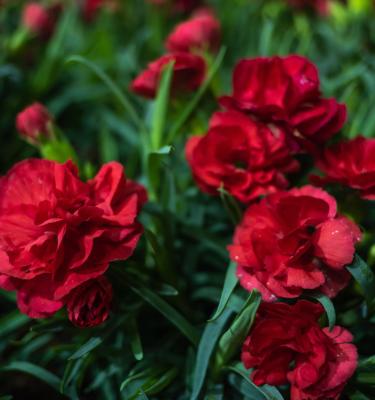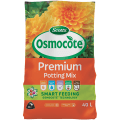

How to grow and care for carnations
Carnations are prized for their beautifully fringed, fragrant blooms, which make excellent long-lasting cut flowers for vases. These delightful flowers begin blooming in late spring and continue well into autumn.
Carnations are versatile and look stunning in cottage gardens, flowering borders, and decorative pots. They thrive in full sun - or light shade in warmer areas - in rich, free-draining soil. Carnations prefer temperate climates with warm summers and mild, wet winters, making them a popular choice for many Kiwi gardeners.
Some varieties of carnations are perennials, blooming for several years, while others are annuals, which die back in autumn and need replanting each spring. Always check the label of the carnation you’re planting to understand its lifecycle and how best to include it in your garden’s design.
Essential shopping list for growing carnations
- A potted carnation plant or seedlings
- Scotts Osmocote Compost Premium Soil Improver
- Garden shovel
- Mulch
- For pots: Scotts Osmocote Premium Potting Mix and Scotts Osmocote Controlled Release Fertiliser: Pots, Planters and Indoors, and a suitable pot or container

Tips for planting carnations outdoors
The best place to plant carnations is a spot with full sun and they require well-drained soil enriched with compost to support healthy growth. Follow these steps to prepare the planting site:
- Mix Scotts Osmocote Compost Premium Soil Improver into the soil. Use a garden shovel to turn the mixture through the top 10 cm of soil.
- Dig a hole twice as wide as the original pot and of the same depth.
- Carefully remove the carnation from its original pot, teasing the roots gently to loosen them. If you’re planting smaller seedlings from a punnet, gently separate each seedling before planting.
- Place the carnation into the prepared soil, following the recommended spacing for the variety. Backfill around the rootball and water thoroughly.
- Apply mulch around the base of the plant to suppress weeds and retain soil moisture. Find out how much mulch you need for your garden.
Tips for planting carnations in pots
Carnations grow well in small to medium pots or planters with good drainage. Use pots that are at least 20 cm wide and deep.
- Fill your pot or planter with Scotts Osmocote Premium Potting Mix.
- Remove the carnation from its original pot, teasing the roots gently if compacted.
- For multiple carnations in one pot, follow the spacing recommendations on the label. Plant the carnations into the potting mix, backfill around the rootball, and water thoroughly.
- Top the potting mix up with mulch to help retain moisture, ensuring the mulch does not touch the stems.

Care for carnation plants
To give carnations the best start, consider improving the soil quality before planting. Once established, carnations benefit from regular fertilising.
Apply Scotts Osmocote Compost Premium Soil Improver for outdoor plants, and Scotts Osmocote Controlled Release Fertiliser when growing carnations in pots. Fertilise in spring and again in summer to support healthy growth and get the best out of their flowering season (late spring through to autumn).
Deadhead carnations throughout their flowering period to encourage continuous blooming. As summer ends or in early autumn, cut back the plants by half to promote a flush of new growth the following spring.
Common carnation pests and diseases
Carnations can occasionally be affected by pests like slugs, snails, aphids, and thrips.
- Slugs and snails: These pests can cause significant damage, especially to young plants and seedlings. Protect them by setting up beer traps (saucers filled with beer) or applying Snail & Slug Killer around the plants.
- Aphids and thrips: These insects can infest carnations from time to time. If you notice damage, spray the plants thoroughly with a suitable insect spray following the label instructions.
Regularly inspecting your carnation plants and addressing infestations promptly will help keep them healthy and looking their best.
Taking care of carnations: FAQs
Are carnations easy to grow?
Yes, carnations are relatively easy to grow in New Zealand, especially in well-drained soil and sunny spots. With the right care, they thrive and produce beautiful, fragrant flowers. They do well in most regions, especially in areas with mild winters and moderate summers.
Where’s the best place to grow carnations?
Carnations prefer full sun, so choose a sunny spot in your garden that gets at least 4-6 hours of direct sunlight a day. They also do well in sheltered areas, as strong winds can damage their flowers.
What’s the best soil for carnations?
Carnations thrive in well-drained, slightly alkaline soil. A sandy or loamy soil with good drainage is ideal. If your soil is clay-heavy, you can improve drainage by adding compost or organic matter. Carnation plants don’t like waterlogged conditions, so make sure the soil doesn’t stay too wet.
Can carnations grow from cuttings?
Yes, carnations can be propagated from cuttings. Take a cutting of a healthy stem (about 10 cm long), remove the lower leaves, and plant it in a pot with well-drained potting mix or seed raising mix. Keep the cutting in a warm, bright spot, and it should root in a few weeks.
Can carnations grow in shade?
Carnations do best in full sun and won’t flower well in full shade. However, they can tolerate partial shade, especially in hotter regions where they may need protection from harsh sun.
Can you grow carnations from seeds?
Yes, carnations can be grown from seeds. Start seeds indoors in early spring, about 8-10 weeks before the last expected frost, or sow them directly outdoors once the weather warms up. They may take some time to flower from seed, but with patience, you’ll be rewarded with vibrant blooms!



